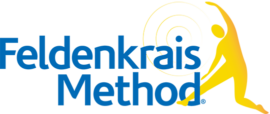What is the Feldenkrais Method of somatic education?
The Feldenkrais Method® of somatic education is a practice, a process, and a system for self-improvement. It is a form of “somatic education,” which means it uses movement and real-time awareness of your own body sensations to guide you toward the positive changes you seek.
The Feldenkrais Method is not a treatment, adjustment, or exercise program. Instead, it is based on decades of research in physics, neuroscience, biomechanics, learning theory, and human development to give you the means to help yourself.
What can the Feldenkrais Method do for me?
The Feldenkrais Method® of somatic education offers a wide range of benefits, as diverse as the individuals who explore the Method. We hope you will find yourself in some of the articles on this website, and can get an idea of how others like you have experienced: whether you are seeking pain relief, dealing with conditions of the central nervous system (multiple sclerosis, cerebral palsy, stroke), or extending your abilities, improving skill, and enhancing creativity.
How does the Feldenkrais Method work?
Your own body awareness and attention stimulates the brain to create new neural pathways that enable optimal movement patterns and function. This brain activity is called “neuroplasticity.” Neuroplasticity is what allows all learning to take place. As you learn better ways to move, you experience improvements in balance, breathing, coordination, flexibility, cognition, and outlook.
Where did the name come from?
The Feldenkrais Method® was developed over 40 years of research by Dr. Moshe Feldenkrais. He was a scientist and an athlete, as well as one of the first Europeans to earn a black belt in Judo. He applied his rigorous scientific approach to the study of movement in order to explore how we learn and how to improve our lives.
What does the Feldenkrais Method have to do with neuroplasticity?
Neuroplasticity is the capacity of the brain and nervous system to renew themselves and grow new connections. Although this ability is greatest in children, scientists in recent years have shown that neuroplasticity continues to function in adults as well. Best-selling author Dr. Norman Doidge writes that neuroplasticity represents “the most important alteration in our view of the brain since we first sketched out its basic anatomy.” We know that neuroplasticity is stimulated through precise, directed attention to a wide variety of gentle and unusual movement possibilities. The Feldenkrais Method® of somatic education thus helps people all over the world to explore their neuroplastic potential.
Is it strenuous?
No. Both Awareness Through Movement® classes, which are taught in a group setting, and Functional Integration® lessons, which are taught one-on-one, are slow, gentle explorations of movement that can be done by anyone, at any level.
I have a lot of pain, and severe movement limitations. Can I still study the Feldenkrais Method?
Absolutely. The wonderful thing about the Feldenkrais Method® is that it is about exploring learning strategies. If you have difficulty with on side, you can work with the other side. If you can’t lie down, you can sit. And even if nothing moves, you can work with your imagination, creating new neural links that can improve your quality of life.
I feel great and perform at my peak. What can the Feldenkrais Method offer me?
There is always room for improvement. You can learn to do what you already do well, more easily, with less effort, so there is energy left over to go even further. Many of Feldenkrais’ biggest adherents are professionals who strive to be their best — Yehudi Menuhin, Martina Navratilova, Dame Judi Dench, to name a few. Weight lifters find the weights seem lighter, tennis players and golfers find their swing more effortless, runners go farther, and performing artists feel they can dance or play the night away.
How is the Feldenkrais Method Different from Massage?
Massage involves soft tissue manipulation. Massage therapists work with muscles and soft tissue. The Feldenkrais Method® is an approach that seeks to affect change by working with your nervous system. Your brain directs the nervous system and is in charge of your movement patterns, so if you want to change your movements you must literally change your mind. As new neural pathways are formed in your brain, you can safely regulate and coordinate your movements, organizing yourself for effective action in the world.
How is the Feldenkrais Method different from yoga?
Unlike yoga, the Feldenkrais Method® does not require you to be flexible, nor does it involve stretching or holding any positions. It also does not involve any practice to perfect positions. Instead of repeating and holding set poses as in yoga, in a Feldenkrais® class you explore gentle and innovative movements as you learn to become aware of habits that may be causing you movement difficulties, inefficiencies, or pain. Many yoga devotees explore the Feldenkrais Method as a way to achieve postures that previously eluded them or that caused discomfort.
How is the Feldenkrais Method different from tai chi?
Unlike tai chi and most martial art disciplines, the Feldenkrais Method® does not require any practice or intensive training to receive its benefits. There are no repetitive movements, and no physical conditioning is required.
How are Feldenkrais practitioners trained?
After successfully completing 160 days of training spread over at least 36 months, graduates are eligible to become certified by the Feldenkrais Guild® of North America. They maintain that certification by fulfilling continuing education and professional practice requirements each year.
Is the Feldenkrais Method covered by insurance?
The Feldenkrais Method® is an educational system that has been shown to have therapeutic benefits. However, in some cases, you may qualify for some reimbursement for your visits. Check with your Feldenkrais® practitioner and insurance provider.

